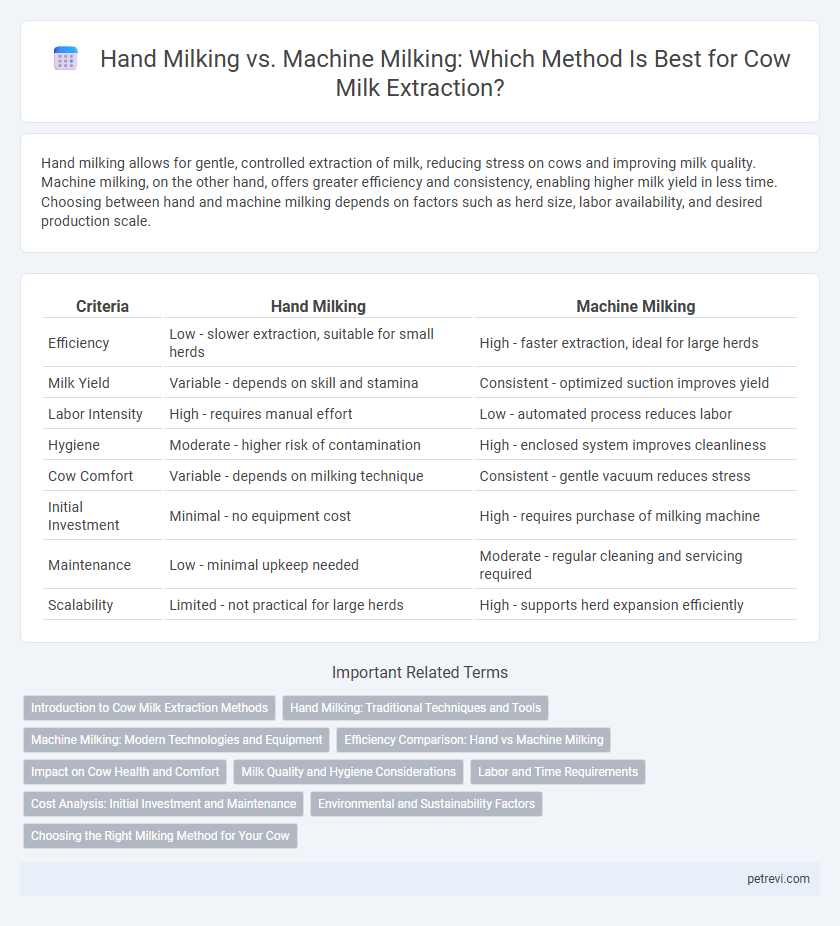Hand milking allows for gentle, controlled extraction of milk, reducing stress on cows and improving milk quality. Machine milking, on the other hand, offers greater efficiency and consistency, enabling higher milk yield in less time. Choosing between hand and machine milking depends on factors such as herd size, labor availability, and desired production scale.
Table of Comparison
| Criteria | Hand Milking | Machine Milking |
|---|---|---|
| Efficiency | Low - slower extraction, suitable for small herds | High - faster extraction, ideal for large herds |
| Milk Yield | Variable - depends on skill and stamina | Consistent - optimized suction improves yield |
| Labor Intensity | High - requires manual effort | Low - automated process reduces labor |
| Hygiene | Moderate - higher risk of contamination | High - enclosed system improves cleanliness |
| Cow Comfort | Variable - depends on milking technique | Consistent - gentle vacuum reduces stress |
| Initial Investment | Minimal - no equipment cost | High - requires purchase of milking machine |
| Maintenance | Low - minimal upkeep needed | Moderate - regular cleaning and servicing required |
| Scalability | Limited - not practical for large herds | High - supports herd expansion efficiently |
Introduction to Cow Milk Extraction Methods
Cow milk extraction methods primarily include hand milking and machine milking, each with distinct techniques and benefits. Hand milking involves manually extracting milk by applying pressure to the cow's teats, often preferred in small-scale or traditional dairy farming for its gentle approach. Machine milking uses automated systems like vacuum pumps to efficiently extract milk, enhancing hygiene and productivity in large-scale dairy operations.
Hand Milking: Traditional Techniques and Tools
Hand milking of cows relies on traditional techniques such as the use of a gentle thumb and forefinger grip to extract milk efficiently while ensuring cow comfort. Essential tools include clean, sanitized metal or plastic buckets to collect milk, and sometimes a milking stool to allow the milker to sit close to the cow. This method supports maintaining milk quality through precise control of milking pressure and reduces the risk of teat injury compared to machine milking.
Machine Milking: Modern Technologies and Equipment
Machine milking employs advanced technologies such as automated milking systems (AMS) with precision sensors and robotic arms that enhance efficiency and hygienic conditions. These systems monitor milk yield, cow health, and teat condition in real time, improving overall dairy farm productivity. High-capacity vacuum pumps and pulsation mechanisms ensure gentle and consistent teat stimulation, reducing the risk of mastitis compared to manual hand milking.
Efficiency Comparison: Hand vs Machine Milking
Machine milking offers significantly higher efficiency than hand milking, extracting milk at a rate of up to 25 liters per cow per hour compared to the 8-10 liters achievable by manual methods. The mechanized process reduces labor time and increases consistency in milk extraction, leading to improved overall productivity on dairy farms. Hand milking requires skilled labor and is more time-consuming, making it less viable for large-scale dairy operations.
Impact on Cow Health and Comfort
Hand milking promotes gentle stimulation of the udder, reducing the risk of teat injuries and mastitis, thereby enhancing cow health and comfort. Machine milking, when properly maintained and adjusted, offers consistent extraction efficiency but may cause teat end hyperkeratosis and stress if overused or improperly calibrated. Regular monitoring and combining both methods can optimize udder health, ensuring better milk quality and animal welfare.
Milk Quality and Hygiene Considerations
Hand milking preserves high milk quality by minimizing equipment contamination and promoting gentle extraction, which reduces somatic cell count and bacterial growth. Machine milking offers efficiency and consistency but requires rigorous cleaning protocols to prevent mastitis and microbial contamination, affecting milk hygiene standards. Optimal milk hygiene depends on balancing proper sanitation practices with the milking method to ensure safety and freshness in dairy production.
Labor and Time Requirements
Hand milking demands significant manual labor and time, typically requiring skilled workers to milk each cow individually, which can take 20-30 minutes per cow. Machine milking streamlines the process, reducing labor input and handling time to about 5-10 minutes per cow, enabling the management of larger herds more efficiently. The mechanized approach minimizes worker fatigue and increases daily milk extraction volume, improving overall farm productivity.
Cost Analysis: Initial Investment and Maintenance
Hand milking requires minimal initial investment, typically involving only basic tools such as milking stools and buckets, resulting in low upfront costs. In contrast, machine milking demands a significant initial outlay for equipment like vacuum pumps, milking clusters, and pulsators, along with ongoing maintenance expenses for parts replacement and technical servicing. Long-term cost analysis shows hand milking remains economically viable for small-scale operations, whereas machine milking offers efficiency advantages that can offset higher costs in larger dairy farms.
Environmental and Sustainability Factors
Hand milking reduces energy consumption and eliminates the need for electricity, making it a more sustainable option compared to machine milking, which relies heavily on power sources and generates noise pollution. Machine milking increases efficiency and milk yield but can contribute to water usage and waste management challenges due to cleaning requirements. Choosing hand milking supports lower carbon footprints and promotes traditional farming practices that align with environmental conservation goals.
Choosing the Right Milking Method for Your Cow
Hand milking allows for gentle extraction and close monitoring of cow health, promoting udder care and reducing the risk of injury, making it suitable for small-scale farms or cows with sensitive udders. Machine milking offers efficiency and consistency, processing multiple cows quickly and maintaining hygiene standards critical in large dairy operations. Selecting the right milking method depends on farm size, cow temperament, and production goals to optimize milk quality and cow welfare.
Hand Milking vs Machine Milking for Cow Milk Extraction Infographic

 petrevi.com
petrevi.com